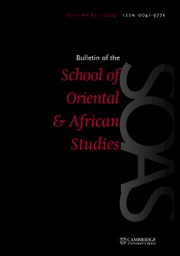This wonderful book joins the British Museum's growing series of highly illustrated and accessible introductions to the cultural history of the world written by the museum's curators that includes China: A History in Objects (2017), The Islamic World: A History in Objects (2020) and Southeast Asia: A History in Objects (2023). Richard Blurton's recent book in this series demonstrates South Asia's rich cultural vitality over the past three millennia to magnificent effect, with over 500 illustrations of landscapes and monuments, rituals and festivals as well as a wide range of objects now in the museum's possession that have been collected over the past 250 years.
The book is arranged chronologically into six sections – Prehistory and early history; Early empires and developing religions; Dynasties and the rise of devotion; Deccan sultans, Mughal emperors and Rajput kings; Europeans and the British in India; and Colonial India, independence and modernity – with an introduction to each period followed by two-page spreads on a particular theme, type of object, or region. The object-focus is a very successful method of illustrating the complexity, variety, and vitality of the region over the past four millennia.
For any reader familiar with Indian art and its histories (and the British Museum's collections) much of the coverage is to be expected, especially the wealth of religious imagery and magnificent court arts: for example, Buddhist sculpture from the Amaravati stupa and Gandhara in north-west India, Hindu temple sculpture in stone and copper alloy from north and south, Mughal and Rajput court paintings. But the great pleasure of the book is its sheer diversity, its surprises and imaginative juxtapositions. India's prehistory is represented not only by the well-known Indus seals of the third to second millennia bce, but also later second- and first-millennia copper axe-heads and silver bull-heads from the Gungeria hoard in central India, gold jewellery from the Nilgiri hills, and iron age ceramics from southern India. The longevity of practices such as gaming is illustrated by a third-millennium ivory stick die from Mohenjo-daro alongside similar dice from the nineteenth century and a painted snakes-and-ladders board with Devanagari labels from the nineteenth-century Punjab Hills.
If volume of production was any measure of the importance of an art form in a society, then textiles should have pride of place in any study of South Asian cultural history, and this book does not neglect the inclusion. An enormous variety of textiles – woven, dyed, and embroidered – have been produced for local consumption, and South Asia has been an important exporter of cloth for well over two millennia: fragments of western Indian block-printing found in Egypt dating to between the thirteenth and fourteenth centuries are illustrated (p. 72); other textiles from the same region were exported to Southeast Asia. More recent textiles are also addressed, including Krishna textiles from Assam, embroidered quilts (kantha) from Bengal, and hand-painted narrative textiles (kalamkari) from southern India.
The material and visual culture of tribal, urban and rural India – “folk” bronzes, chromolithography – are discussed alongside the traditions of temple and court, narrating the cultural history of South Asia into the present. A welcome surprise is the attention given to the colonial and modern periods narrated with reference to new media such as photography, as well as art and music: a sitar made in 1961 for the internationally renowned Pandit Ravi Shankar was donated to the British Museum in 2017. Visitors to the British Museum may not have realized the quality of paintings by major figures of Indian Modernism, including both Abanindranath and Rabindranath Tagore, Jamini Roy, Mukul Dey and later members of the Progressive Artists Group – Francis Newton Souza, M.F. Husain – and Neotantric artists such as Biren De. Modern and contemporary art from Pakistan, Sri Lanka, and Bangladesh are represented too.
In sum, this is a wonderfully personal curation of objects that offers a rich perspective on India's cultural history, reflecting the author's more than three decades of work with the British Museum's collection. His depth of knowledge, sympathy with, and curiosity for the region are evident throughout this fine book which should leave many readers hungry for more: may this book encourage them to deepen their understanding and appreciation for the profound impact of South Asia on our global, interconnected world.



